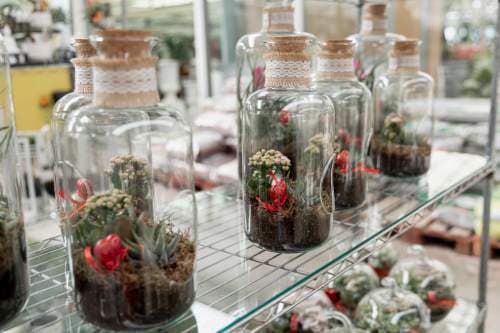The art of terrarium design reaches new heights when you introduce rare botanical specimens. Beyond common houseplants, a carefully selected rare plant can transform your terrarium into a living museum of botanical wonders.
The Allure of Rarity
What makes a plant truly rare? Sometimes it's scarcity in cultivation, evolutionary uniqueness, or simply challenging growth requirements that few can master. When you introduce these botanical treasures into your terrarium, you're not just creating a display—you're preserving living art.
The pursuit of rare specimens connects us to a tradition of botanical collection that stretches back centuries, when explorers would risk everything to discover new species in remote corners of the world.

Miniature Marvels: Micro-Orchids
Perhaps no family of plants offers more terrarium-suitable rarities than orchids—specifically, the fascinating world of miniature orchids. These tiny treasures often grow no larger than a coin and produce flowers smaller than a pencil eraser.
Pleurothallis microphylla
With leaves barely 1cm across, this miniature marvel produces proportionally large purple flowers that emerge directly from the leaf surface.

Lepanthes telipogoniflora
Producing alien-like blooms with delicate "whiskers," this miniature orchid creates an otherworldly focal point in any terrarium.

Bulbophyllum alagense
This miniature wonder produces clusters of flowers that resemble tiny birds in flight, all from a plant that could fit on your fingertip.


Iridescent Wonders
Some rare plants earn their status through unique visual properties. The iridescent blue shine of Begonia pavonina isn't just beautiful—it's an evolutionary adaptation. The plant's specialized leaf structures maximize light absorption in dim rainforest settings, creating that signature blue shimmer.
When placed in a terrarium, these iridescent plants create an almost magical effect as they catch and reflect light from different angles. Other iridescent specimens worth seeking include Selaginella willdenowii and certain Calathea varieties.
Carnivorous Curiosities
Few plants command attention like miniature carnivorous species. While Venus flytraps often get all the publicity, smaller and rarer species offer more sustainable terrarium options.

Cephalotus follicularis
The Australian pitcher plant forms tiny, ornate "pitchers" with ribbed rims and translucent "windows" that disorient insects. Unlike many other carnivorous plants, Cephalotus can thrive in a closed terrarium environment when properly acclimated.
Their compact growth makes them perfect for creating an eye-catching feature that visitors will inevitably ask about. The contrast between their burgundy pitchers and emerald leaves adds striking visual interest.

Drosera adelae
The lance-leaved sundew creates a mesmerizing display with its linear leaves covered in red, dew-tipped tentacles that glisten in the light. Native to a small region in Queensland, Australia, this rare sundew thrives in terrarium conditions.
Unlike many sundews, D. adelae tolerates lower light levels and higher humidity, making it ideal for closed terrariums. Its architectural form creates natural structure within your micro-landscape.
"In a well-designed terrarium, rare plants aren't merely decorative elements—they're the protagonists of a story, inviting viewers to lean in closer and discover their secrets."
Jewel Orchids: Beyond the Bloom
While most orchids are prized for their flowers, jewel orchids captivate with their extraordinary foliage. These terrestrial orchids feature leaves with metallic veining, iridescent surfaces, or velvet textures.

Macodes petola
Often called the "lightning jewel orchid," its dark green leaves feature golden veining that appears to glow from within. The intricate patterns resemble electrical discharges frozen in time.

Ludisia discolor
The black velvet jewel orchid features deep burgundy leaves with contrasting red-pink veins. Its velvety texture and rich color make it perfect for adding depth to terrarium compositions.
Cultivation Considerations
While rare plants can elevate your terrarium to extraordinary heights, they do require specialized care. Before introducing rare specimens, consider:
- Research thoroughly - Each rare species has specific requirements. Invest time in learning about their natural habitat and needs.
- Start with proper acclimation - Many rare plants are sensitive to environmental changes. Gradually introduce them to terrarium conditions.
- Create microhabitats - Design your terrarium with specific zones that cater to different plants' needs, from moisture levels to light exposure.
- Source ethically - Ensure your rare plants come from reputable growers who propagate their stock rather than wild-collecting threatened species.
- Consider compatible companions - Some rare plants compete poorly with aggressive growers. Pair them with species that won't overwhelm them.
Where to Find Rare Specimens
Finding rare terrarium plants requires looking beyond garden centers and big-box stores. Consider these specialized sources:
- Botanical garden sales and events
- Specialist online nurseries
- Plant society meetings and shows
- Social media plant communities and exchanges
Many serious collectors form relationships with specific growers who alert them when rare specimens become available. Patience is essential—the most extraordinary plants are worth waiting for.

Creating Conversations
Beyond their beauty, rare plants offer something invaluable—stories. Each unusual specimen becomes a conversation starter, whether you're sharing details about a plant's unique adaptations or its journey from a remote mountain top to your living room.
When you incorporate rare plants into your terrarium designs, you're not just creating a display; you're preserving botanical diversity, supporting specialized growers, and connecting to a global community of plant enthusiasts who appreciate these living treasures.
The next time you design a terrarium, consider looking beyond the commonplace. With careful selection and proper care, rare specimens will reward you with not just beauty, but a deeper connection to the remarkable diversity of the plant kingdom.


